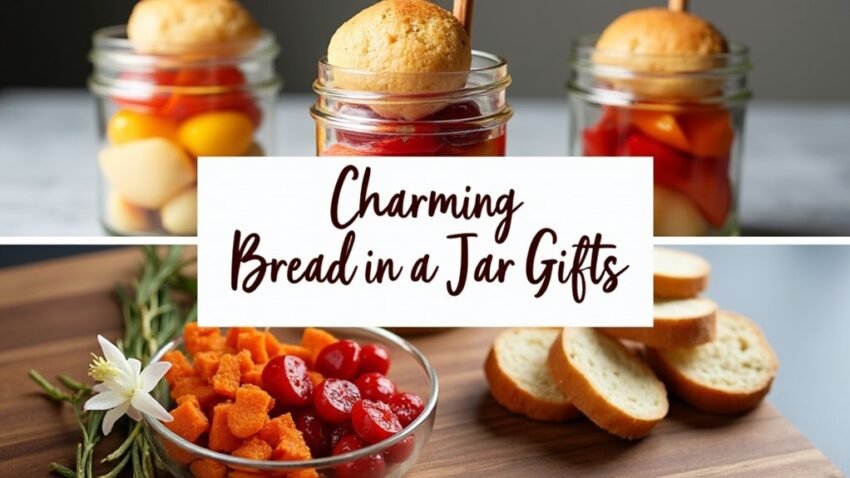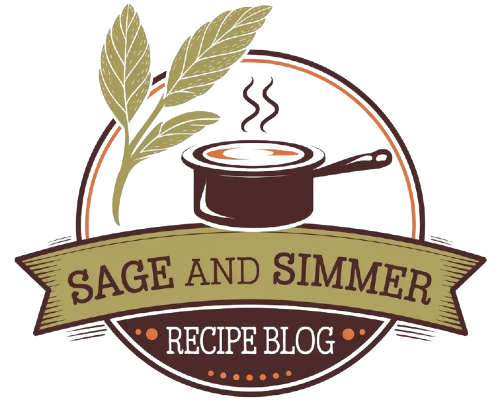Charming Bread in a Jar Gifts

Charming Bread in a Jar Gifts
When you think about gift-giving, have you considered the unique charm of bread in a jar? This gift not only showcases your thoughtfulness but also invites the recipient into the joy of baking. Picture a beautifully layered jar filled with dry ingredients, complete with a tag that guides them through the simple process of creating their own loaf. It’s a delightful blend of creativity and practicality, yet there’s more to these charming gifts than just the ingredients. What makes them truly special might surprise you, especially when you investigate the personal touches you can add.
Key Takeaways
- Use wide-mouth mason jars for easy filling and a charming rustic presentation of your bread gifts.
- Include decorative ribbons or twine to enhance the visual appeal of the jars.
- Attach printed tags with baking instructions and a “use by” date for added care and personalization.
- Consider pairing jars with ceramic bread dishes or utensils for a thoughtful gifting experience.
- Enhance the charm with artisanal jellies or flavored butters to complement the bread.
History
Bread has a rich history that dates back to ancient Mesopotamia, where it first emerged nearly 10,000 years ago. As you investigate this fascinating journey, you’ll uncover the significant role bread has played in various civilizations.
-
Ancient Civilizations: The origins of bread are intertwined with the development of agriculture and the domestication of grains.
-
Early Leavening: Europeans realized leavening through the brewing of beer, leading to the creation of sourdough.
-
Roman Empire: By the 2nd century B.C., commercial bakeries became influential, with bakers controlling production and often holding civic power.
-
Bakers Guild: In 168 B.C., the Bakers Guild established strict regulations for baking practices.
Bread’s cultural significance is profound, symbolizing nourishment, wealth, and community. The Romans utilized bread as a means of control, coining the phrase “Bread and Circuses.” Bread served as a form of currency in various cultures, notably in Ancient Egypt, where it was exchanged for labor.
Economically, bread prices could spark social unrest, evidenced by events like the “Flour War.”
Throughout history, bread has evolved from a simple staple to a complex symbol of society’s values, reflecting both the communal and economic aspects of daily life.
Understanding its history enriches your appreciation for this timeless food.
Recipe
Recipe
Making charming bread in a jar is a delightful way to share homemade goodness with friends and family. This recipe not only provides a delicious treat but also makes for a unique and personal gift. The process of baking bread in jars combines the fun of cooking with the joy of giving, resulting in beautifully presented loaves that can be enjoyed fresh or kept as a keepsake. Baking in jars enhances moisture retention due to steam sealing, ensuring your bread stays fresh longer.
To start, you’ll need to gather your ingredients and confirm you have the right equipment. Wide-mouth mason jars are ideal for this recipe, as they allow for easy filling and serve as an attractive presentation. Keep in mind to measure your ingredients accurately for the best results, and feel free to experiment with additional flavorings to create a personalized touch.
Ingredients
- 2 cups all-purpose flour
- 1 cup granulated sugar
- 1/2 cup melted butter
- 1/2 cup buttermilk
- 2 large eggs
- 1 tsp baking soda
- 1/2 tsp salt
- 1 tsp vanilla extract
- Optional: chocolate chips, nuts, or spices
Cooking the bread in a jar involves preheating your oven to 325°F (165°C) and greasing the inside of your mason jars to prevent sticking.
In a large bowl, combine the dry ingredients (flour, sugar, baking soda, and salt) and mix well. In another bowl, whisk together the melted butter, buttermilk, eggs, and vanilla extract. Gradually add the wet ingredients to the dry mixture, stirring until just combined.
Carefully spoon the batter into the prepared jars, filling them about 2/3 full. Place the jars directly on the oven rack and bake for 25-30 minutes, or until a toothpick inserted in the center comes out clean. Once baked, remove the jars from the oven and let them cool slightly before sealing with sterilized lids.
When baking bread in jars, it’s essential to confirm that all your ingredients are at room temperature for better mixing and rising. Keep an eye on the baking time, as it may vary slightly depending on your oven and the size of the jars used.
For a decorative touch, consider adding ribbons or labels to your jars once they’re completely cooled. Finally, store any leftover bread in a cool, dry place, and keep in mind that homemade bread is best enjoyed fresh within a week.
Final Thoughts
Creating charming bread in a jar not only fills your kitchen with delightful aromas but also leads to a thoughtful gift that leaves a lasting impression. This gift improves the giving experience, showcasing your effort and care through a personalized touch. You can customize each jar with artisanal jellies or flavored butters, making it even more special.
Consider the presentation as an essential element. Use decorative ribbons or twine for a rustic look, and include printed tags with clear instructions. For an added touch, think about pairing the mix with a ceramic bread dish or utensils. A well-designed label raises the gift, giving it a professional appearance. Additionally, including a “use by” date ensures recipients can enjoy the bread at its freshest, enhancing the gift’s overall quality.
The impact of homemade gifts extends beyond the moment. They inspire recipients to bake more and cultivate a deeper appreciation for homemade food. Plus, they’re budget-friendly, making them ideal for any occasion, from Christmas to casual gestures.
Bread in a jar mixes offer versatility. You can vary the ingredients, create themed gift baskets, or pair them with complementary foods like jams or cheeses. Ultimately, this thoughtful gift fosters meaningful connections and memorable experiences for you and your loved ones.
FAQ
Curiosity often drives questions about charming bread in a jar gifts. Here are some frequently asked questions to guide you.
What are the basic ingredients?
You’ll typically need flour, active dry yeast, salt, sugar or alternatives like sucanat, and optional nuts or seeds.
What’s the preparation process?
1. Mix dry ingredients separately.
2. Combine wet ingredients if needed.
3. Merge wet and dry mixes.
4. Fill mason jars with dough.
5. Bake in the oven.
How can I improve the gift?
Consider including:
– A ceramic bread dish
– Homemade jelly or honey
– Butter or spreads
Additionally, you might want to add a note about the shelf-life of up to 12 months for the bread in a jar.
What about storage and safety?
Store jars in a cool, dry place and verify they’re sealed properly. Follow safe baking practices, like avoiding overly hot liquids that can kill yeast.
What are some creative variations?
You can try monkey bread with cinnamon sugar, sourdough, or use unique ingredients like sunflower seeds.
